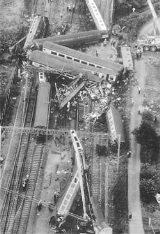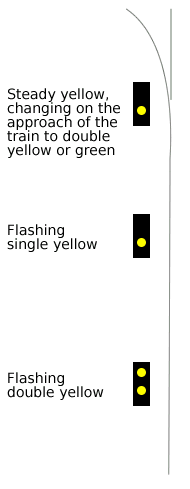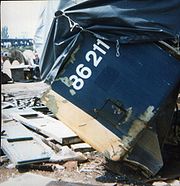
Colwich rail crash
Encyclopedia
The Colwich rail crash occurred on the evening of Friday 19 September 1986 at Colwich Junction
, Staffordshire
, England
. It was significant in that it was a high speed collision between two packed express train
s. No passengers were killed, because of the great strength of the rolling stock
involved, which included examples of Mk1, Mk2
and Mk3
coaches.
and Stafford
and is where the four-track West Coast Main Line
from London
splits into two routes. Approaching from the south, two tracks go to Manchester
via Stoke-on-Trent
, and two tracks go to Stafford
and Crewe
. In the middle of the layout, two of the lines cross each other at a diamond crossing.
In August 1986, the signalling was altered so that drivers of northbound trains taking the Stoke line would see flashing yellow signals on approach. Flashing yellows signify that the junction is clear, but that the train must slow down in order to safely take the diverging route. This sequence of signalling was designed for use at higher-speed turnout
s as a replacement for approach release from red, where the junction signal is held at red until the train is near to it.
Over the next few years, flashing yellows were also installed at locations where trains cross over between different tracks travelling in the same direction, e.g. from a "fast" line to a "slow" line. While not "junctions" in the traditional sense, the signalling sequence was identical to that given at a "diverging" route.
 On 19 September 1986, the signalman
On 19 September 1986, the signalman
at Colwich saw that the 17:00 express train
from London Euston to Manchester was approaching the junction at roughly the same time as the 17:20 express from Liverpool
to Euston. He decided to give precedence to the latter and so the Manchester train might need to wait its turn over the junction.
The Manchester train needed to cross from the Down Fast to the Down Slow line before turning off towards Stoke. The signals presented to its driver were as follows:
After going through the crossover he saw CH23 at red. Having interpreted that the flashing yellows meant that the route all the way over the junction to Stoke was clear, he was expecting this signal to clear as he got near to it (as under the old approach-control system). But, as he got nearer to it, he realised it was not going to clear.
The driver made an emergency brake application but the train did not stop before reaching the diamond crossing. At that moment he saw the Liverpool train approaching at high speed and shouted a warning to a trainee driver who was also in the cab. They both jumped from the locomotive almost immediately before the Liverpool train collided with it.
The locomotive of the Liverpool train was 86211 City of Milton Keynes
. It hit the other locomotive 86429 The Times
side-on, which finished up in the wreckage with its body twisted and split open. The passenger coaches were scattered in all directions and some had their ends badly damaged. Eric Goode, the driver of no. 86211, was killed.
 After the accident, the driver went to the signal box
After the accident, the driver went to the signal box
and told the signalman "You had double flashing yellows and the route was set for Stoke". With "traditional" junction layouts in mind, he thought that flashing yellows meant that the line was clear for him right through the junction. It was not; the signalling system regarded the crossover from the Down Fast to the Down Slow as the "junction", and the driver was not expecting to see a red signal before taking the Stoke line.
The public inquiry
centred on whether the driver had had adequate training on the recently introduced flashing yellow signals and the implications at multiple junctions (Hall 1987). The driver admitting to signing for, but not actually reading, the Notice that referred to the installation of flashing yellows at Colwich the previous month.
A contributory factor was the lack of flank protection given the layout at Colwich Junction. The accident would not have happened if the points had been set for the train to go parallel to, rather than head-on into, the Liverpool train's path; similarly to Ladbroke Grove
(Hall 2003), and as would have been normal practice in an older manual installation.
Colwich Junction
Colwich Junction is a rail junction on Britain's West Coast Main Line, near the town of Little Haywood, Staffordshire. It was the site of the 1986 Colwich rail crash...
, Staffordshire
Staffordshire
Staffordshire is a landlocked county in the West Midlands region of England. For Eurostat purposes, the county is a NUTS 3 region and is one of four counties or unitary districts that comprise the "Shropshire and Staffordshire" NUTS 2 region. Part of the National Forest lies within its borders...
, England
England
England is a country that is part of the United Kingdom. It shares land borders with Scotland to the north and Wales to the west; the Irish Sea is to the north west, the Celtic Sea to the south west, with the North Sea to the east and the English Channel to the south separating it from continental...
. It was significant in that it was a high speed collision between two packed express train
Train
A train is a connected series of vehicles for rail transport that move along a track to transport cargo or passengers from one place to another place. The track usually consists of two rails, but might also be a monorail or maglev guideway.Propulsion for the train is provided by a separate...
s. No passengers were killed, because of the great strength of the rolling stock
Rolling stock
Rolling stock comprises all the vehicles that move on a railway. It usually includes both powered and unpowered vehicles, for example locomotives, railroad cars, coaches and wagons...
involved, which included examples of Mk1, Mk2
British Rail Mark 2
The Mark 2 family of railway carriages were British Rail's second design of carriages. They were built by British Rail workshops between 1964 and 1975...
and Mk3
British Rail Mark 3
British Rail's third design of standard carriage was designated 'Mark 3' , and was developed primarily for the InterCity 125 High Speed Train...
coaches.
Background
Colwich Junction lies between RugeleyRugeley
Rugeley is a historic market town in the county of Staffordshire, England. It lies on the northern edge of Cannock Chase, and is situated roughly midway between the towns of Stafford, Cannock, Lichfield and Uttoxeter...
and Stafford
Stafford
Stafford is the county town of Staffordshire, in the West Midlands region of England. It lies approximately north of Wolverhampton and south of Stoke-on-Trent, adjacent to the M6 motorway Junction 13 to Junction 14...
and is where the four-track West Coast Main Line
West Coast Main Line
The West Coast Main Line is the busiest mixed-traffic railway route in Britain, being the country's most important rail backbone in terms of population served. Fast, long-distance inter-city passenger services are provided between London, the West Midlands, the North West, North Wales and the...
from London
London
London is the capital city of :England and the :United Kingdom, the largest metropolitan area in the United Kingdom, and the largest urban zone in the European Union by most measures. Located on the River Thames, London has been a major settlement for two millennia, its history going back to its...
splits into two routes. Approaching from the south, two tracks go to Manchester
Manchester
Manchester is a city and metropolitan borough in Greater Manchester, England. According to the Office for National Statistics, the 2010 mid-year population estimate for Manchester was 498,800. Manchester lies within one of the UK's largest metropolitan areas, the metropolitan county of Greater...
via Stoke-on-Trent
Stoke-on-Trent
Stoke-on-Trent , also called The Potteries is a city in Staffordshire, England, which forms a linear conurbation almost 12 miles long, with an area of . Together with the Borough of Newcastle-under-Lyme Stoke forms The Potteries Urban Area...
, and two tracks go to Stafford
Stafford
Stafford is the county town of Staffordshire, in the West Midlands region of England. It lies approximately north of Wolverhampton and south of Stoke-on-Trent, adjacent to the M6 motorway Junction 13 to Junction 14...
and Crewe
Crewe
Crewe is a railway town within the unitary authority area of Cheshire East and the ceremonial county of Cheshire, England. According to the 2001 census the urban area had a population of 67,683...
. In the middle of the layout, two of the lines cross each other at a diamond crossing.
In August 1986, the signalling was altered so that drivers of northbound trains taking the Stoke line would see flashing yellow signals on approach. Flashing yellows signify that the junction is clear, but that the train must slow down in order to safely take the diverging route. This sequence of signalling was designed for use at higher-speed turnout
Railroad switch
A railroad switch, turnout or [set of] points is a mechanical installation enabling railway trains to be guided from one track to another at a railway junction....
s as a replacement for approach release from red, where the junction signal is held at red until the train is near to it.
Over the next few years, flashing yellows were also installed at locations where trains cross over between different tracks travelling in the same direction, e.g. from a "fast" line to a "slow" line. While not "junctions" in the traditional sense, the signalling sequence was identical to that given at a "diverging" route.
The accident

Signalman (rail)
A signalman or signaller is an employee of a railway transport network who operates the points and signals from a signal box in order to control the movement of trains.- History :...
at Colwich saw that the 17:00 express train
Express train
Express trains are a form of rail service. Express trains make only a small number of stops, instead of stopping at every single station...
from London Euston to Manchester was approaching the junction at roughly the same time as the 17:20 express from Liverpool
Liverpool
Liverpool is a city and metropolitan borough of Merseyside, England, along the eastern side of the Mersey Estuary. It was founded as a borough in 1207 and was granted city status in 1880...
to Euston. He decided to give precedence to the latter and so the Manchester train might need to wait its turn over the junction.
The Manchester train needed to cross from the Down Fast to the Down Slow line before turning off towards Stoke. The signals presented to its driver were as follows:
| Signal no. | Aspect | Meaning |
|---|---|---|
| CH105 | Flashing double yellow | Advance indication of diverging route ahead |
| CH103 | Flashing single yellow | Indication of diverging route ahead |
| CH28 | Single yellow with route indicator | Next signal at Danger. Next set of points have been set for a diverging route. |
| CH23 | Red | Danger - stop |
After going through the crossover he saw CH23 at red. Having interpreted that the flashing yellows meant that the route all the way over the junction to Stoke was clear, he was expecting this signal to clear as he got near to it (as under the old approach-control system). But, as he got nearer to it, he realised it was not going to clear.
The driver made an emergency brake application but the train did not stop before reaching the diamond crossing. At that moment he saw the Liverpool train approaching at high speed and shouted a warning to a trainee driver who was also in the cab. They both jumped from the locomotive almost immediately before the Liverpool train collided with it.
The locomotive of the Liverpool train was 86211 City of Milton Keynes
British Rail Class 86
The British Rail Class 86 was the standard electric locomotive built during the 1960s, developed as a result of testing with the earlier Classes 81, 82, 83, 84 and 85. One hundred of these locomotives were built from 1965-1966 by either English Electric at Vulcan Foundry, Newton-le-Willows, or...
. It hit the other locomotive 86429 The Times
British Rail Class 86
The British Rail Class 86 was the standard electric locomotive built during the 1960s, developed as a result of testing with the earlier Classes 81, 82, 83, 84 and 85. One hundred of these locomotives were built from 1965-1966 by either English Electric at Vulcan Foundry, Newton-le-Willows, or...
side-on, which finished up in the wreckage with its body twisted and split open. The passenger coaches were scattered in all directions and some had their ends badly damaged. Eric Goode, the driver of no. 86211, was killed.
Investigation

Signal box
On a rail transport system, signalling control is the process by which control is exercised over train movements by way of railway signals and block systems to ensure that trains operate safely, over the correct route and to the proper timetable...
and told the signalman "You had double flashing yellows and the route was set for Stoke". With "traditional" junction layouts in mind, he thought that flashing yellows meant that the line was clear for him right through the junction. It was not; the signalling system regarded the crossover from the Down Fast to the Down Slow as the "junction", and the driver was not expecting to see a red signal before taking the Stoke line.
The public inquiry
Public inquiry
A Tribunal of Inquiry is an official review of events or actions ordered by a government body in Common Law countries such as the United Kingdom, Ireland or Canada. Such a public inquiry differs from a Royal Commission in that a public inquiry accepts evidence and conducts its hearings in a more...
centred on whether the driver had had adequate training on the recently introduced flashing yellow signals and the implications at multiple junctions (Hall 1987). The driver admitting to signing for, but not actually reading, the Notice that referred to the installation of flashing yellows at Colwich the previous month.
A contributory factor was the lack of flank protection given the layout at Colwich Junction. The accident would not have happened if the points had been set for the train to go parallel to, rather than head-on into, the Liverpool train's path; similarly to Ladbroke Grove
Ladbroke Grove rail crash
The Ladbroke Grove Rail Crash was a rail accident which occurred on 5 October 1999 at Ladbroke Grove, London, England. Thirty-one people were killed and more than 520 injured...
(Hall 2003), and as would have been normal practice in an older manual installation.
Recommendations
The Inspector's report recommended changing the signalling sequence so that flashing yellows would only be used when the line was clear throughout the whole junction, as the driver was expecting. A second recommendation was removing wheelslide prevention in an emergency braking situation - practical tests suggested the train could then have stopped before fouling the junction. The latter recommendation was not implemented.Memorial
Local resident Alf Taylor created a memorial to Eric Goode at the site of the accident, which he looked after until his death in 1997. On 17 September 2006, the Sunday before the 20th anniversary of the accident, the garden was re-dedicated.External links
- BBC News: On this day: 19 September
- BBC news: BBC News article relating 20th anniversary of crash

